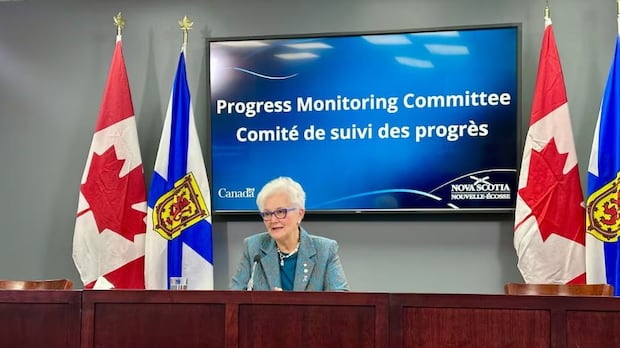Blind woman nearly hit at intersection raises questions about construction accessibility

Milena Khazanavicius and her guide dog, Hope, find it difficult to negotiate the streets in her north-end Halifax neighbourhood in the best of circumstances.
But after she was nearly struck by a vehicle last week while struggling to cross an intersection being reconfigured to accommodate bike lanes, she says the city needs to step up its game to improve accessibility in construction zones.
“Construction and navigation in the city in general has been down the drain in the past three years,” said Khazanavicius, who is blind.
Khazanavicius’s close call happened on the evening of Aug. 14 after she got off a bus near the corner of Windsor and Almon streets and found a barricade blocking her way forward.
She backtracked and tried to cross at another part of the intersection, with Hope guiding her around some of the gravelled areas and obstructions in the work zone. But she said she could not hear the usual accessible pedestrian signals, cars began honking at her and one came close to striking her.
She said another pedestrian intervened at that point and helped get her across the street, leading her around construction pylons and another barricade.
A spokesperson for Halifax Regional Municipality said after receiving complaints about the intersection, it instructed the contractor the following day to take action to “ensure the area was accessible for all road users.”
The city recognizes “these issues can be more difficult for people who are blind or partially sighted,” it said in a statement responding to questions about accessibility in construction areas.
The city said it reopened one of the quadrants in the intersection, but Khazanavicius said that wasn’t sufficient enough to enable accessible use of the street.
She pointed out a sign warning of a work zone ahead was obstructing a sidewalk and could be imperceptible for a person walking with a cane, creating a potential injury hazard.

She said constant changes such as the relocation or addition of pylons, barricades and signs makes it even harder to navigate the area because it makes her route inconsistent and impossible to memorize.
CBC News returned to the intersection at Windsor and Almon on Aug. 16 and found barricades had been moved again and the accessible pedestrian signals were not operating.
The barricades would make it nearly impossible for Khazanavicius to get from her usual bus stop to her nearby house without crossing the street at a non-designated area with no traffic lights or crosswalks.
Asked once again about the situation, the city spokesperson said staff “frequented zones to ensure they are user-friendly and accessible.”
“We continuously strive to improve the accessibility of our construction projects,” the statement said.

For Khazanavicius, it’s not the first time she’s spoken out about what she calls a dangerous intersection.
In a letter sent to Halifax Regional Municipality on July 9, she and other advocates with the Canadian National Institute for the Blind raised concerns about the proposed design of the cycling lane along Almon Street.
The group wrote that while they recognize the necessity of creating bike lanes, “the deployment of cycling infrastructure and its impact on vulnerable pedestrians remains poorly understood.”
CNIB had warned that this specific construction project would affect people who are blind or visually impaired as its office is located nearby. But Khazanavicius, who has been advocating for the rights of people with disabilities for seven years, feels none of her complaints were heard at the time.
“I can attest that I’ve had conversations off record with people who are in charge and there have been mistakes made here already that [have] been identified,” she said.
In February, a city staff report said municipal staffers had consulted community advocates, including people with vision loss and Walk ‘n Roll Halifax, road builders, engineers and developers to look into improving accessibility rules around construction sites.
The city said the CNIB letter had only addressed design aspects and not construction concerns, but they “engaged with the CNIB before construction” and maintained ongoing discussions.




